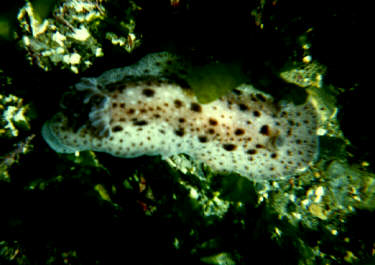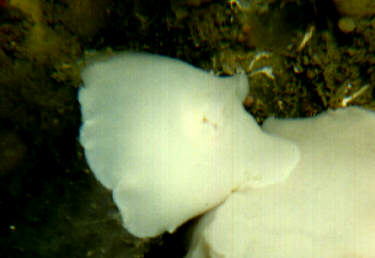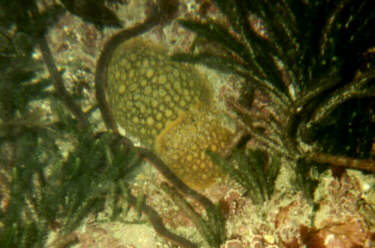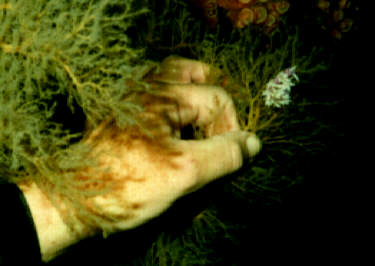Nudibranchs
Butterflies of the sea
Archidoris
Wellingtonensis Dorids
Chromodoris
Aeolidia
 Nudibranchs are
sea slugs and are closely related to their land cousins and to snails. Ooh yuk. Wait
though! Nudibranchs hold the position under the sea that butterflies do on land. They are
the flash of colour - the iridescent glow and the reason many divers swim slowly and
observantly alongside rocky walls.
Nudibranchs are
sea slugs and are closely related to their land cousins and to snails. Ooh yuk. Wait
though! Nudibranchs hold the position under the sea that butterflies do on land. They are
the flash of colour - the iridescent glow and the reason many divers swim slowly and
observantly alongside rocky walls.
They are the 'Wow' of the sea!
They gain their name from the fronds around their tail end - their 'naked gills' or
'nudi branches' which are exposed to the sea currents. Around Wellington their colours are
generally not as vivid as they are further north. Perhaps it is our cooler water that
makes the majority of our nudi's a pale colour with grey or brown flecks. They are
hermaphrodite (dual sex) and lay eggs in a flat ribbon wound into a spiral, much like a
rose bud shape. I have observed mauve, white and yellow egg spirals.
Nudibranchs are generally poorly recorded and few are scientifically named except for
the efforts made by some determined individuals. However, there are web
sites devoted to them and there are some excellent reference books available. I
suggest Neville Coleman's Nudibranchs of the South Pacific as a starting
point. (Published by Neville Coleman, PO Box 702, Springwood QLD 4127, Australia, ISBN 0
947 325 02 6).
Other Names: Warty sea slug. (Archidoris = ancient or original Doris)
Habitat: Rocky coastlines, from low tide to 40 metres.
Identification: Archidoris is the largest of our nudibranchs and may grow up
to 12 cm (5 inches) in length. The back is covered in large warty lumps and the underside
of the foot is bright orange.
General: In the Marine Lab aquarium at Island Bay archidoris produced pale
yellow spirals of eggs. Although they were fairly active at the aquarium, I get the
feeling archidoris might be nocturnal. At sea during the daytime they seem to
imitate a lumpy sponge on a rock and are certainly not as active as the two in the (R18)
picture.
About Dorids: Doridacea, named after Doris, a sea nymph in Greek mythology.
Has fronds (gills) on the back rear and 'ears' (smelling sensors called rinophores)
towards the front.
Habitat: Rocky coastlines out of direct currents or surge.
 Identification:
Around Wellington I have seen variations from pure white, to white with a few grey
blotches, to mostly brown. We may not have many other varieties of nudibranchs, but we
have plenty of dorids.
Identification:
Around Wellington I have seen variations from pure white, to white with a few grey
blotches, to mostly brown. We may not have many other varieties of nudibranchs, but we
have plenty of dorids.
 A white dorid
held in a yellow lunch box gradually turned a lemon colour to match its surroundings. This
did not help identification by colour!
A white dorid
held in a yellow lunch box gradually turned a lemon colour to match its surroundings. This
did not help identification by colour!
General: Commonly seen (when searched for) at The Sirens and Princess Bay, among other
sites. Egg rosette's seen have been white, yellow and mauve-pink
About Chromodorids: Chromodoris aureo-marginata or similar. Chromo = coloured.
Gold-banded nudibranch.
Habitat: Rocky coastlines out of direct current or surge.
Identification: Generally small around Wellington (to 3 cm's), white with a coloured
margin. I have seen both an orange stripe and a lime green stripe around the edge of these
nudi's. Chromodoris aureo-marginata was described by Tony and Jenny Enderby in
Dive Log NZ (Issue 38). 'These can be found all around New Zealand. While diving in one
location in Dusky Sound, Fiordland, we found hundreds of these nudibranchs, mostly grazing
on kelp. Depth here was around ten metres. The body is white with a narrow orange-yellow
margin. Size is up to 45 mm'.
General: Commonly around Princess Bay and The Sirens.
About Aeolids: Aeolidia - from Aeolis, the Greek god of the wind. Aeolids have
lots of hair-like filaments on their backs (cerata) which blow in the wind (current).
Habitat: The only aeolid I have seen around Wellington (Jason miribalis) was
at 34m on a sea mount 1.5 - 2 km off Lyall Bay among rocky reefs.
Jason miribalis was described by Tony and Jenny Enderby in Dive Log NZ (Issue
38). 'Although not discovered until 1970, the Jason is now commonly found all
around New Zealand, from three metres to below 30 metres. They are one of the most
beautiful of New Zealand's nudibranchs and are up to 60 mm in length. The Jason
nudibranch has a striking translucent pink body with white rinophores and finger-like
projections known as cerata on the back. The egg masses are a similar pink colour. It is
almost always found on solenderia hydroids. The family of nudibranchs accumulate
the stinging cells from the hydroids in their cerata as a deterrent to predators.'
General: I was excited when I discovered this 'new' nudibranch at the Lyall Bay sea
mount. However, after checking my nudi' pictures, I was a little embarrassed to find that
Mary Carney had already introduced me to Jason at the Poor Knights. A picture of
Mary's hand (and a Jason) shown for your viewing pleasure.
Seaweed
Home The Egg Page
 Nudibranchs are
sea slugs and are closely related to their land cousins and to snails. Ooh yuk. Wait
though! Nudibranchs hold the position under the sea that butterflies do on land. They are
the flash of colour - the iridescent glow and the reason many divers swim slowly and
observantly alongside rocky walls.
Nudibranchs are
sea slugs and are closely related to their land cousins and to snails. Ooh yuk. Wait
though! Nudibranchs hold the position under the sea that butterflies do on land. They are
the flash of colour - the iridescent glow and the reason many divers swim slowly and
observantly alongside rocky walls. 

 Identification:
Around Wellington I have seen variations from pure white, to white with a few grey
blotches, to mostly brown. We may not have many other varieties of nudibranchs, but we
have plenty of dorids.
Identification:
Around Wellington I have seen variations from pure white, to white with a few grey
blotches, to mostly brown. We may not have many other varieties of nudibranchs, but we
have plenty of dorids. A white dorid
held in a yellow lunch box gradually turned a lemon colour to match its surroundings. This
did not help identification by colour!
A white dorid
held in a yellow lunch box gradually turned a lemon colour to match its surroundings. This
did not help identification by colour!